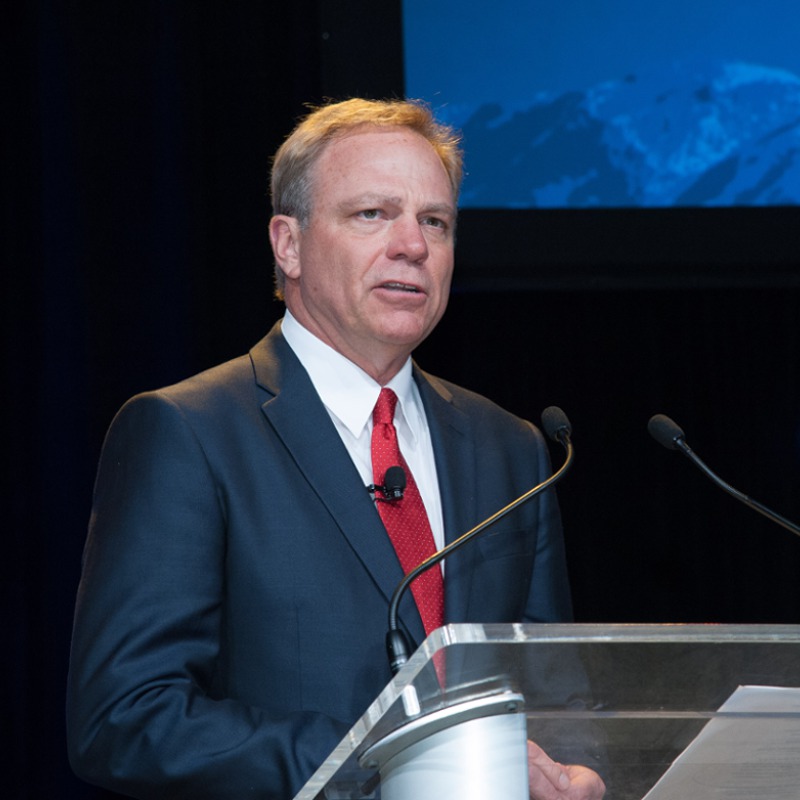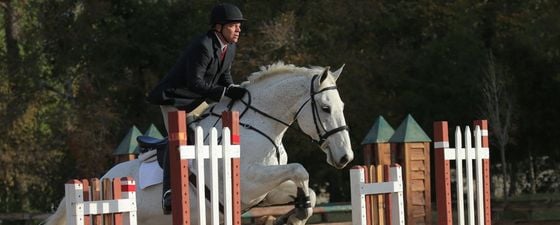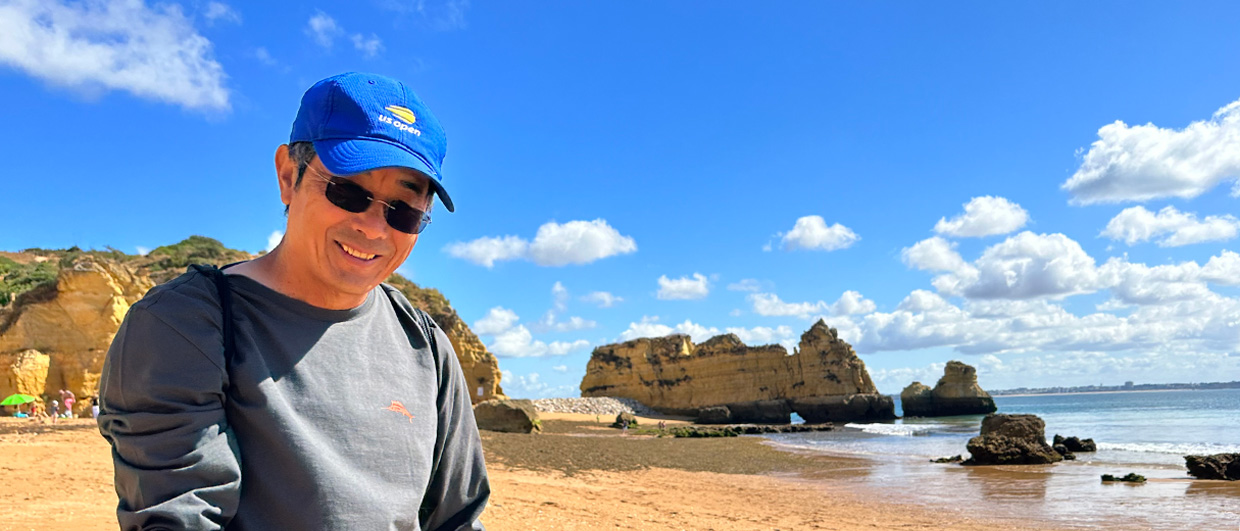“This year has just been a whirlwind of seeing new places and meeting people,” says Lee Krystinik, describing his time as the President of the American Association of Petroleum Geologists (AAPG). “And I’ve loved every minute of it! I’ve just come back from a two-week tour of the Middle East – my first trip to the region, taking in Qatar, Saudi Arabia and the UAE – and I was both humbled and exhilarated by the excellent geoscience being done by remarkably talented and passionate colleagues there. It is wonderful to know that the world over we geoscientists love what we do; geoscience is a common bond regardless of language or culture.”
Lee’s tenure as President is the culmination of a long-term connection with the organisation, which he thinks is a vital, important and growing resource for the worldwide oil and gas industry.
“I joined the AAPG while I was still an undergraduate student of geology at the University of Texas at Arlington, and immediately had the opportunity to volunteer to serve on the AAPG Publications Committee – that was lots of fun. I thought then, and still think, that AAPG is the most important oil and gas geoscience and professional society in the world.”
The World in a Sand Grain
Lee’s interest in geology dates back to his childhood in the Dallas-Fort Worth area of Texas. “This area is so rich in fossils that one of the local creeks in which I hunted fossils was called Fossil Creek. Some of the most beautifully preserved fossils came from a black, organic-rich shale that I later came to know as the mid-Cretaceous Eagleford Formation – all that preserved organic matter makes it a pretty good resource play too! It seemed to make sense to me to see these in the flat Texas ground, not so terribly far away from the call of seagulls on the Texas coast – but on a family holiday to Colorado when I was about seven years old I was amazed to see these same fossilised creatures encased in steeply dipping strata at the top of a mountain. How did they get there? What did the world look like back then? I was hooked! I became particularly fascinated by the concept of palaeoenvironments, trying to envisage a world with huge trees that looked like asparagus plants, two-metre long dragonflies, and super scorpions a metre across. Imagining that kept me excited by geology – and still does.”
After his undergraduate degree, Lee moved to Princeton University to undertake a Masters and then a Ph.D., in which he continued his interest in palaeoenvironments by looking at the deposition and diagenesis of reservoirs and source rock in turbidite deposits in California. At this point new techniques for scrutinising the components of rocks at the microscopic level, such as SEM (scanning electron microscopy), and XRF and XRD (X-ray fluorescence and X-ray diffraction) were just coming to the fore, and Lee was delighted to find that these new tools were helping prove many theories in sedimentology and diagenesis studies.
“I was amazed; I could see the world in a grain of sand!” he explains. “I was able to trace the turbidites I was studying as they went deeper and deeper into the earth, and using these techniques I could look at a whole range of diagenetic features and work out many aspects of the depositional history. And this ultimately led me to the oil industry, as I developed ideas about predicting the sedimentological character of a potential reservoir from inspecting the properties of sands under the microscope.”
A Varied Career
 Lee giving the opening address at the AAPG Annual Conference and Exhibition in Houston in April, 2014. (Source: L. Krystinik)“I like to find out how things work and to learn new things,” Lee says. “There is so much to learn in geology, I think I’ll be studying all my life.” This enquiring mind has led to a varied career, from undertaking a summer field season in Alaska looking at complex sandstones (“and bears, caribou, amazing scenery; a wonderful experience”), to rising through the ranks of Union Pacific Resources (formerly Champlin Petroleum) to become Manager of Geology responsible for exploration strategy and developing the company’s portfolio of assets, primarily in the USA and Canada.
Lee giving the opening address at the AAPG Annual Conference and Exhibition in Houston in April, 2014. (Source: L. Krystinik)“I like to find out how things work and to learn new things,” Lee says. “There is so much to learn in geology, I think I’ll be studying all my life.” This enquiring mind has led to a varied career, from undertaking a summer field season in Alaska looking at complex sandstones (“and bears, caribou, amazing scenery; a wonderful experience”), to rising through the ranks of Union Pacific Resources (formerly Champlin Petroleum) to become Manager of Geology responsible for exploration strategy and developing the company’s portfolio of assets, primarily in the USA and Canada.
“I have worked in the full range of industry arenas, including offshore and deepwater, but my big focus has been on continental, coastal and deltaic environments, not just in North America but also in the Middle East, Asia and Latin America.
“When I was with Union Pacific we became one of the first companies to turn exploring for and producing hydrocarbon resources into something like a manufacturing assembly line process, exploiting economies of scale, so our rigs were continually working. In the early ’90s we were exploring in the Austin Chalk in Texas, in a band with both heavy and light oil, and as we progressed deeper we encountered higher and higher pressures and temperatures, so we required more and more progressive technology. Sun originated the horizontal drilling effort in the Austin Chalk, porpoising up and down through the formation looking for presumed fracture swarms. We followed on by drilling using the concept of ‘zonation’ for very specific horizontal target selection, enabling us to stay in optimally fractured and porous target zones and to used real-time geosteering to meet these. I find it fascinating to work in these high tech developments, especially when the geology is fully integrated with geophysics and engineering to derive an optimal result.”
In 2000 Lee left Union Pacific to set up his own company, Krystinik Litho-Logic, a consultancy specialising in the application of new concepts and technology (such as sequence stratigraphy, syn-sedimentary tectonics,fracture analysis, horizontal drilling and various completion techniques) to reservoir prediction. He was then tempted back to the corporate arena as Global Chief Geologist with Conoco Phillips. “Working in a large multinational company with a global reach was a very different and stimulating environment for me,” he explains. “I had a fast learning curve, with a remit to evaluate what we did well, what we didn’t and where to focus for the best financial outcomes. The experience reminded me of how important teams are. None of us, no matter how bright or hard-working, can possibly know all that is required to execute a global exploration and development programme. Successful exploration requires a technically excellent team who make a point of open communication at all points along the path.
Giving Something Back
“I usually wake up excited to go to work and I think most geoscientists feel the same,” Lee says. “It is great to see our younger colleagues approaching petroleum geoscience with the same passion, enjoyment. There is always something new to learn in geology, which is one reason I have loved being involved with the AAPG. I have been given so much through the overwhelming generosity of people I have come to know through AAPG. Through the gift of their time and knowledge, shared during many phases of my career, my colleagues have taught me virtually all I know. I owe it to the profession to give something back.
“Many people ask me what is the relevance of organisations like the AAPG today – why be a member when there is so much information available online, for example? For young people in particular there is still a huge amount of geoscience knowledge to be gleaned through membership, attendance at conferences and training conferences and in reading the journals and publications of the association.
“As you progress in your career, from the very beginning, the most important aspect of AAPG membership is the connections it gives you within the oil and gas community; connections with a group of people who have the same goal as you – simply to find oil and gas,” Lee continues. “With a membership of over 40,000 people from 118 countries across the globe, the AAPG is a continuous resource of opportunities to learn from, and with, experienced people doing just that. You have the possibility of meeting people who are working on similar situations and rocks as you are, perhaps from very different countries and backgrounds, and to discuss the issues and challenges facing us all.
“The depth and complexity of the AAPG is huge – by the end of my two years in office (as President-Elect and then President) I will just about know the job,” he jokes. “We are very keen to support the long-term strategic growth of the industry. Although we are a sciencebased association run to a large extent by the excellent efforts of volunteers, we are becoming more businessoriented.
There is a lot of competition, particularly in the conferences arena, from other organisations like the EAGE and SPE, so rather than competing we are concentrating on cooperation – arm in arm towards a common goal.
The annual International Petroleum Technology Conference (IPTC), which rotates between the Middle East and the Asia Pacific region, is a fine example of such cooperation as it organised jointly by the EAGE, SEG, SPE and ourselves in the AAPG, and the specialist Unconventional Resources Technology Conference, URTeC, is another illustration. In my opinion, the more cooperation we can achieve, the better we can serve the customer – which incidentally highlights another way in which AAPG is changing. We used to be focused on our members, but now, with at some meetings as many as 75% of the attendees non-members, we think more in terms of customers, with our members being the most important of those.
Risk-Taking
Lee enjoys active sports like skiing and riding, and is a natural risk-taker “but then aren’t all exploration geologists?” he asks. “You don’t ever want to think you’re going to drill a dry hole – but many wells don’t find hydrocarbons; you have to learn to expect some failures, but not be knocked back by them. You need that element in your personality to keep exploring.
“Similarly, in my life I like to be challenged by exciting new things, with a steep learning curve – I don’t do anything by halves! I want to live life to the full and experience many different things, and also to remember and learn from how they affected me. For example, a few years ago I did a tandem sky dive, which was an unforgettable experience. During it I tried very hard to concentrate on all the details of how I felt both mentally and physically, and what I experienced throughout the jump, to really appreciate the experience. The same goes for long, steep hikes at altitude – the physical challenge is intense and the risk is quite real, but the views and the feeling at the top make it more than worthwhile!”
Lee originally met his partner, also a geologist, on an AAPG-sponsored field symposium, and discovering her love for horse-riding, himself took up the sport. Typically, he wasn’t content with simply jogging around the highways and byways of his home near Tulsa in Oklahoma; instead he took up the rather more challenging competitive sport of three-day eventing, in which the horse and rider compete through the very demanding disciplines of dressage and show-jumping, before hurtling at full speed round a course, several miles long, littered with ‘natural’ jumping obstacles like tree trunks and solid walls. “I enjoy three-day eventing because it has forced me into circumstances where I may be in ‘control’ but my ‘sporting partner’ has a huge say over the outcome,” he explains. “Our relationship drives our success or failure (severe injury or death, for one or both of us, is one of those potential failure scenarios) and understanding that linkage applies in many different aspects of personal and professional life. Teamwork and mutual respect are critical in all we do. Besides, it is a blast rumbling at top speed, on a stunningly powerful, nearly one ton animal, off across the countryside and jumping over large, immovable objects. I don’t find myself pondering whether the next well will be good or not while out on that cross country course!”
Next Giant Leap?
What of the future? “Many of us in society today are concerned about the earth and the effect of burning fossil fuels, and we are right to be. We need to continue supporting research into alternative fuels and systems, but meanwhile, it is our job to bridge the energy gap while these are made more efficient, and I believe that natural gas is the most efficient, low total carbon footprint resource we have at the moment,” Lee says.
“We need to find more oil and gas. Spreadsheets or algorithms don’t do that – geologists and geophysicists do. It’s their job to aggressively address the unknown and come up with something new. This requires a different mindset – I think of it as equations and vigorous methodology versus imagination.”
So what will be the next giant leap? “I don’t know – but it’s a challenge we all face and can solve together – and that’s why I could never have asked for a more enjoyable and satisfying career,” Lee concludes.





